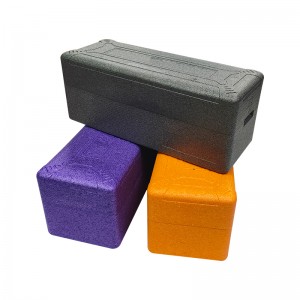EPP insulated boxes have become an indispensable partner for us, playing an important role in outdoor camping, long-distance travel, and daily catering delivery. EPP (Expanded Polypropylene) insulated boxes have become a popular choice in the market due to their excellent performance. Today, let's explore the production process of EPP insulation boxes and understand how they have gradually transformed from raw materials into practical tools in our hands.

1、 Preparation of raw materials
The production of EPP insulation boxes began with high-quality polypropylene particles. These particles are the foundation of EPP materials, and they undergo a series of physical changes during the production process, forming foamed materials with insulation and seismic properties. The selection of polypropylene particles has a decisive impact on the performance of the final product, therefore, strictly screened raw materials will be selected to ensure their purity and stability.
2、 Foaming process
Put polypropylene particles into a special foaming machine, and through heating and high-pressure treatment, expand the gas inside the particles, forming countless tiny bubbles. This process is called physical foaming, which gives EPP materials lightweight and good insulation performance. The temperature and pressure control during the foaming process is crucial, which directly affects the size and distribution of bubbles, thereby affecting the insulation effect and compressive capacity of the insulation box.
3、 Forming and cooling
The foamed EPP material needs to be formed through a molding machine. The molding machine shapes the EPP material into the desired shape through high temperature and pressure. This step requires precise mold design to ensure that the size and shape of the insulation box meet the design requirements. After molding, the EPP material will be cooled to harden and maintain its formed shape.

The main applications of EPP insulation boxes:
Food preservation: Due to its environmental friendliness, good thermal stability, and insulation properties, EPP materials are very suitable for food preservation and insulation transportation.
Cold chain logistics: EPP insulated boxes can maintain a low temperature state inside the box for a long time, suitable for long-distance transportation of temperature sensitive products such as drugs, biological products, frozen foods, etc. In cold chain logistics, these insulated boxes can ensure the quality and safety of products during transportation and distribution.
Building insulation: Due to the insulation performance of EPP materials, they can also be applied in the field of construction, such as insulation and sound insulation of building floors.
In addition to the above-mentioned purposes, EPP environmental insulation boxes can also be customized according to different needs to meet the insulation requirements of special fields. When selecting an EPP insulation box, factors such as size, shape, and foaming rate need to be considered based on actual usage purposes and conditions to ensure the best insulation effect and economic benefits.
Post time: Apr-07-2024
